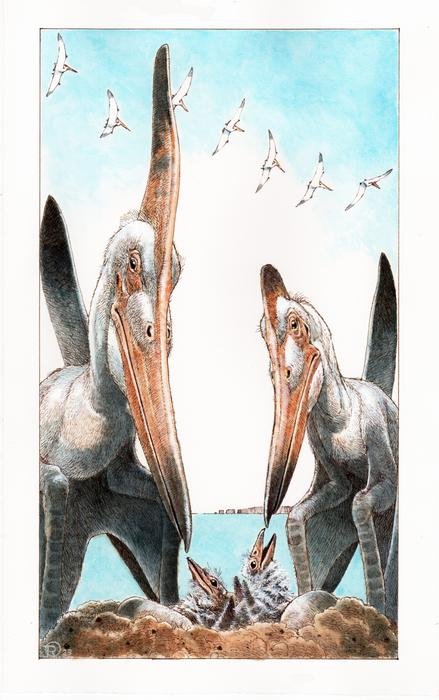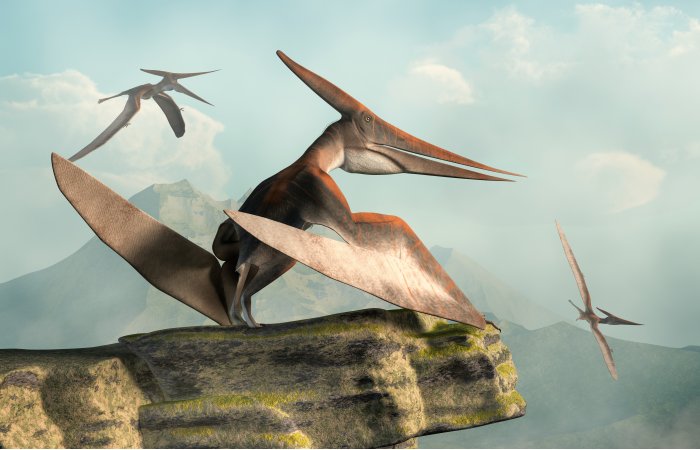Eddie Gonzales Jr. – AncientPages.com – Did the pterosaurs, flying reptiles from the days of the dinosaurs, practice parental care or not? New research by scientists from Ireland (University College Cork), China (Nanjing and Yunnan Universities), and the UK (University of Bristol and Queen Mary University of London) shows that pterosaurs were indeed caring parents – but only the larger species.
This solves a long-standing conundrum. To be able to fly soon after hatching from the egg, a bird or pterosaur must have well-developed wings. Studies of smaller pterosaurs from the Jurᴀssic showed that their babies already had large wings when they hatched, and they could have wobbled into flight within a few days of birth.

Yang et al. (2023) show that large-bodied pterosaurs, such as the giant Pteranodon (shown here), probably practiced parental care. Unlike small pterosaurs, which were born with well-developed wings and could fly soon after hatching, large pterosaurs were born with small arms that would not have facilitated active powered flight, and parental care would have been essential to survival of the young and enabling them to grow to huge sizes. Credit: Artwork James Robins/UCC
But did this work for the later pterosaurs, which were much larger in size? In the Cretaceous, pterosaurs usually had wingspans of 5 metres, and some even reached 10–15 metres, the size of a small glider.
“This was a difficult project,” says the study leader, Dr Zixiao Yang from University College Cork (UCC). ‘We needed examples of pterosaurs where we had at least one hatchling or very young specimen as well as adults so we could study their growth rates. But baby pterosaurs are really rare.”
Dr. Yang collaborated with Professor Baoyu Jiang from Nanjing University, Professor Michael Benton of the University of Bristol, Professor Xu Xing of Yunnan University, and Professor Maria McNamara of UCC on the research.
“Luckily, we were able to use some classic specimens from the Jurᴀssic of Europe and the Cretaceous of North America, together with new finds from China. By measuring the skulls, backbones, wings, and hind legs, we were able to test for differences in the relative growth of different parts of the body.”
The research focussed on testing the allometry, or how the creatures’ characteristics changed with size.
“We are all familiar with allometry in human babies, puppies, and kittens – their heads, eyes, and knees are huge, and the rest of the body grows faster to get to adult proportions. It’s the same with many animals, including dinosaurs and pterosaurs. The babies have cute faces, with short noses, big eyes, and big heads,” Dr Yang said.
“The small, bird-sized, Jurᴀssic pterosaurs were born with large wings and strong arms and legs, evidence that the babies could fly from birth. As they grew from baby to adult, their arms and legs showed negative allometry, meaning they started large and were then growing more slowly than the rest of the body.”
“But it was different for the Cretaceous giants. They also started as small babies, but the key limb bones show positive allometry through growth, suggesting a very different developmental model.”
“This means that the pterosaur giants had sacrificed low-input childcare to the need to grow huge eventually as adults. Minimal childcare makes sense in the early evolutionary history of these ancient reptiles because it saves energy. But to grow huge, the larger pterosaurs had a problem – it basically took much longer to become an adult, and therefore parents needed to protect their young from accidents.

A pteranodon perches on a rocky outcropping while two others fly by. One of the largest flying reptiles, these pterosaurs lived during the cretaceous period. Credit: Adobe Stock – Daniel Eskridge
The babies of all pterosaurs, large and small, were small because of the limitations of egg size. Investing in childcare by having non-flying babies was offset in evolutionary terms by allowing pterosaurs to evolve truly huge sizes.”
“We see the same thing in birds and mammals today. Some birds fly very young, and of course, some mammals like cattle and antelopes are on their feet the day they are born. But this kind of behavior is risky for the babies because they are often clumsy and are easy targets for predators; it’s also costly for the mother because the babies must have highly developed wings or legs at the point of birth. So, we see the same thing in extinct pterosaurs. They were restricted in maximum body size until the end of the Jurᴀssic, at which point their parental care behavior changed, and then they could achieve huge sizes.”
The paper ‘Allometric wing growth links parental care to pterosaur giantism’ is published in the journal Proceedings of the Royal Society B.
Written by Eddie Gonzales Jr. – AncientPages.com – MessageToEagle.com Staff





